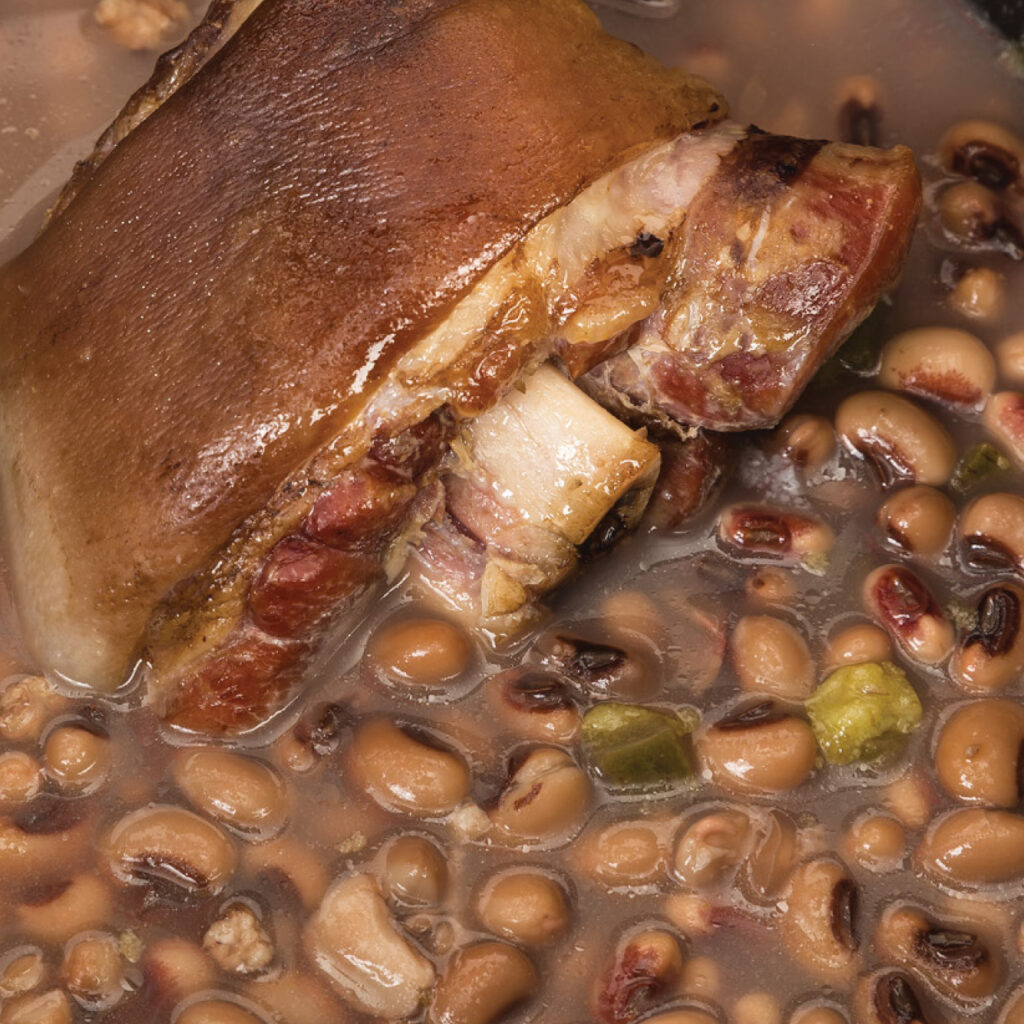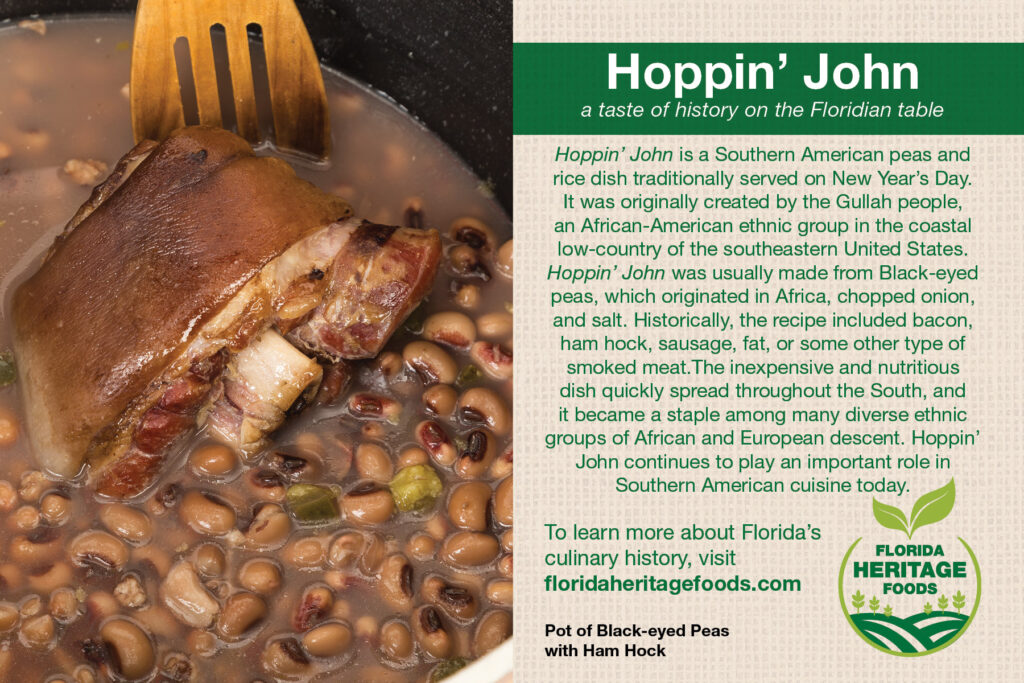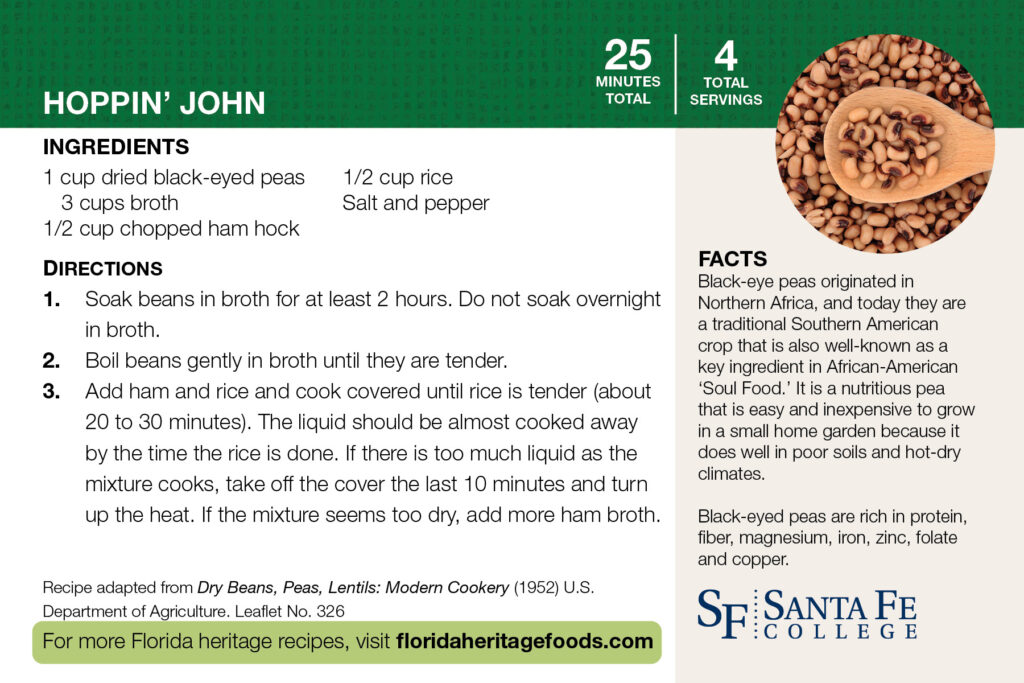Hoppin’ John is a Southern American peas and rice dish traditionally served on New Year’s Day. It was originally created by the Gullah people, an African-American ethnic group in the coastal low-country of the southeastern United States. Hoppin’ John was usually made from Black-eyed peas, which originated in Africa, chopped onion, and salt. Historically, the recipe included bacon, ham hock, sausage, fat, or some other type of smoked meat.The inexpensive and nutritious dish quickly spread throughout the South, and it became a staple among many diverse ethnic groups of African and European descent. Hoppin’ John continues to play an important role in African-American Soul Food and Southern American cuisine today.

Hoppin’ John originated as a one-pot dish created by the Gullah people, an African-American ethnic group who have predominantly lived within the coastal plains, or ‘Lowcountry’ region, of South Carolina, North Carolina, Georgia, and Florida. It is believed to have evolved from rice and bean dishes that were the subsistence of enslaved West Africans, and it has been traced to similar dishes in West Africa such as the Senegalese dish thiebou niebe. The Gullah version of Hoppin’ John Hoppin’ John was usually made from Black-eyed peas, which originated in Africa, chopped onion, and salt. Historically, the recipe included bacon, ham hock, sausage, fat, and or some other type of smoked meat because pigs were a common livestock kept by enslaved and formerly enslaved African-American. An inexpensive and nutritious dish, Hoppin’ John quickly spread throughout the Southern United States, in both African and European-American households and into the Caribbean and Latin America. The oldest print reference to Hoppin’ John is in Recollections of a Southern Matron (1838). A recipe was later published in The Carolina Housewife (1847) by Sarah Rutledge, and it was mentioned in Frederick Law Olmsted’s 19th century travelog, A Journey in the Seaboard Slave States (1861) where he writes, “The greatest luxury with which they are acquainted is a stew of bacon and peas, with red pepper, which they call ‘Hopping John’.” Hoppin’ John is widely consumed throughout the Southern United States today, yet it has largely lost its name and is commonly referred to as simple ‘black-eyed peas and rice.’
Once Hoppin’ John became a common Southern American dish, it was soon associated with good luck, particularly as a New Year’s Day feast, because peas were considered symbolic of currency. A complete New Year’s Day meal consisted of Hoppin’ John, stewed greens, such as collards or mustard, to represent print money and cornbread to represent gold. At a set table, coins were often placed beneath the dish. Dishes created from leftovers after New Year’s Day were referred to as “Skippin’ Jenny,” and the dishes represented continued frugality throughout the rest of the year. Today, a wide variety of ‘peas and rice’ and ‘beans and rice’ variations exist throughout a broad spectrum of culturally diverse cuisines in the Southern region of the United States, the Caribbean, and Latin America.
Hoppin’ John originated as a one-pot dish created by the Gullah people, an African-American ethnic group who have predominantly lived within the coastal plains, or ‘Lowcountry’ region, of South Carolina, North Carolina, Georgia, and Florida. It is believed to have evolved from rice and bean dishes that were the subsistence of enslaved West Africans, and it has been traced to similar dishes in West Africa such as the Senegalese dish thiebou niebe. The Gullah version of Hoppin’ John Hoppin’ John was usually made from Black-eyed peas, which originated in Africa, chopped onion, and salt. Historically, the recipe included bacon, ham hock, sausage, fat, and or some other type of smoked meat because pigs were a common livestock kept by enslaved and formerly enslaved African-American. An inexpensive and nutritious dish, Hoppin’ John quickly spread throughout the Southern United States, in both African and European-American households and into the Caribbean and Latin America. The oldest print reference to Hoppin’ John is in Recollections of a Southern Matron (1838). A recipe was later published in The Carolina Housewife (1847) by Sarah Rutledge, and it was mentioned in Frederick Law Olmsted’s 19th century travelog, A Journey in the Seaboard Slave States (1861) where he writes, “The greatest luxury with which they are acquainted is a stew of bacon and peas, with red pepper, which they call ‘Hopping John’.” Hoppin’ John is widely consumed throughout the Southern United States today, yet it has largely lost its name and is commonly referred to as simple ‘black-eyed peas and rice.’


Santa Fe College Partnered with Multiple Organizations in a Collaborative Effort to Bring Awareness of the Heritage Plants In Florida.
BY CULTURAL HISTORY
BY GROWING SEASON
DROUGHT TOLERANT PLANTS
Commitment to Equal Access and Equal Opportunity
Santa Fe College is committed to an environment that embraces diversity, respects the rights of all individuals, is open and accessible, and is free of harassment and discrimination. For more information, visit sfcollege.edu/eaeo or contact equity.officer@sfcollege.edu.
SACSCOC Accreditation Statement
Santa Fe College is accredited by the Southern Association of Colleges and Schools Commission on Colleges (SACSCOC). For more information, visit sfcollege.edu/sacscoc.
